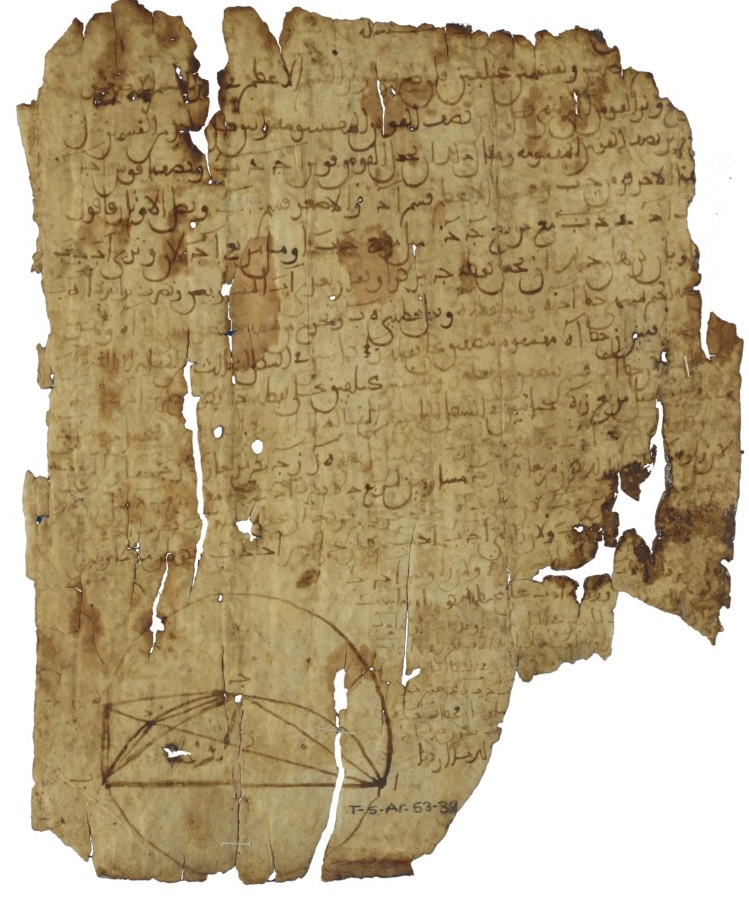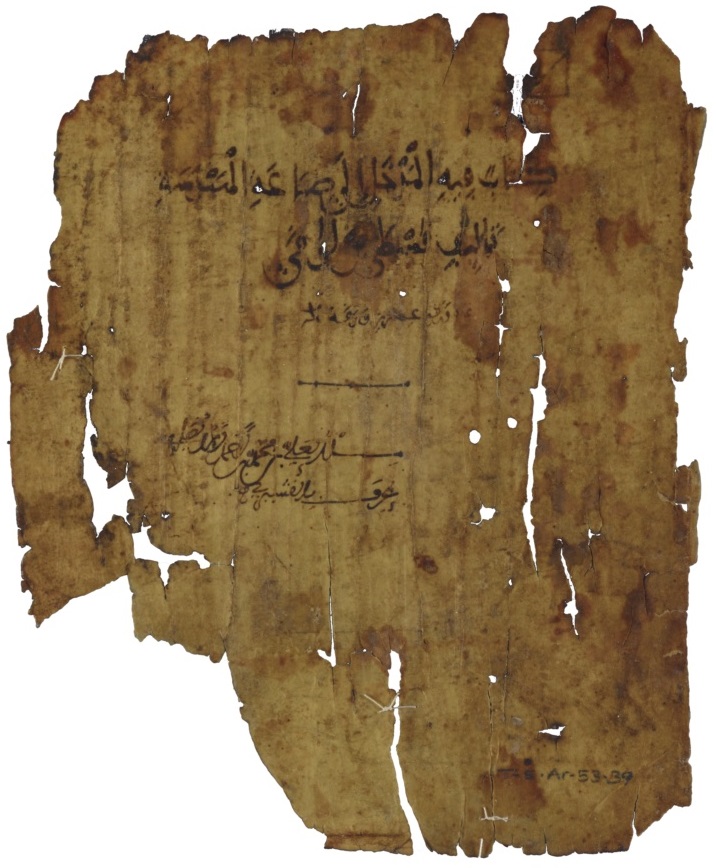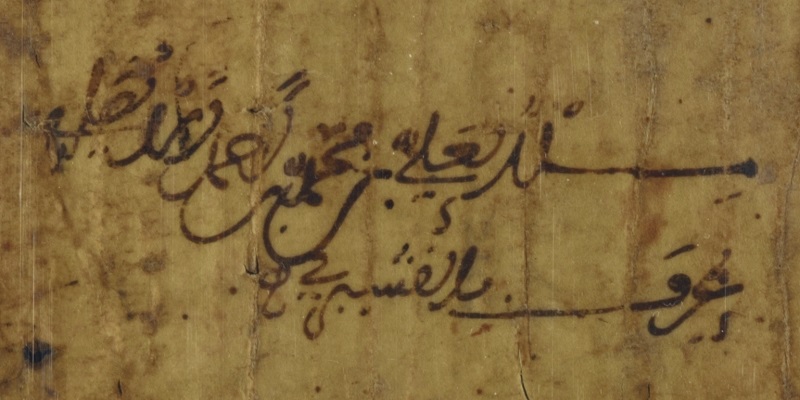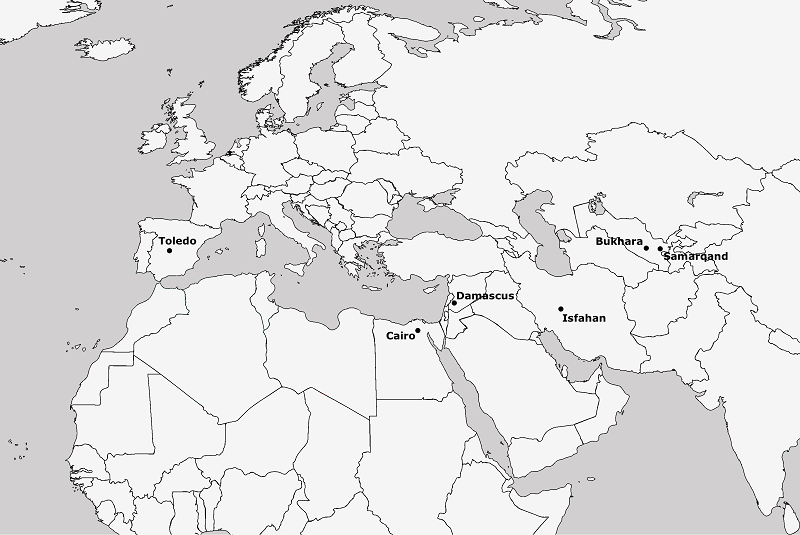The Long Road to Samarqand: Reverse-Engineering the Travels of a 12th-Century Andalusi Muslim (T-S Ar.53.39)
Over the last 5 years, I have written about several different Cairo Genizah manuscripts for our Fragment of the Month series. Most of the time, I pick a fragment that I’ve spent many days studying to identify what it is and where it came from.1 These manuscript mysteries often lead to new discoveries that can be fun to figure out, but not every Genizah fragment is so mysterious. The truth is, many tell us exactly what they are.
The trick is recognising how any fragment we’re looking at fits into the wider story of the Genizah and the Middle East. Does it tell us something new about an understudied historical phenomenon? Is the text from a lost work or does it survive in other manuscripts? Are there records of the author elsewhere or is this the only reference to them? Is it an original document or a copy taken out of context? This month’s fragment is one of those manuscripts that is exactly what it says on the tin. It offers us a glimpse into the 12th-century intellectual world and the long journey of a forgotten Muslim scholar from southern Spain.
T-S Ar.53.39 is a parchment folio measuring 21.2 x 17.2 cm. It is stained from water damage and much of the ink has faded. The edges, especially around the outer margins, are torn. Remnants of sewing holes in the inner margin suggest it is the surviving half of a bifolium that was once bound in a codex. The large Arabic writing on the verso is the title page of this codex, identifying the text and its author. It reads: “A book containing The Introduction to the Art of Geometry, the composition of Qustā ibn Luqā.” Below this title is a damaged line that describes the original form of the codex: “Number of leaves: twenty leaves.”2


T-S Ar.53.39 recto and verso
Qustā ibn Luqā (820-912 CE) was a Syrian Melkite Christian polymath from Baalbek in what is now Lebanon. He participated in the ninth-century ‘translation movement’, which saw the rulers of the Abbasid Caliphate sponsoring scholars to collect valuable scientific works and translate them into Arabic.3 Syriac Christians like Ibn Luqā and his contemporary, the famed Ḥunayn ibn Isḥāq (808-873 CE), were already familiar with Syriac, Greek, and Arabic, so they were the ideal scholars for this translation work.4 Ibn Luqā travelled to the Byzantine Empire to collect Greek manuscripts for translation, and he wrote The Introduction to the Art of Geometry (al-Madkhal ilā Ṣināʿat al-Handasa), among other works, based on his knowledge of these ancient Greek sources.
As we can see from the recto of T-S Ar.53.39, the scribe who produced this copy of The Introduction to the Art of Geometry also illustrated it using geometric diagrams labelled with Arabic characters. This scribe was well-trained in Arabic calligraphy, demonstrating command of a distinctive maghrebi script style. Maghrebi, the Arabic word for ‘western’, denotes the styles of Arabic scripts that developed in North Africa and al-Andalus during the medieval period. This manuscript has two of the most common maghrebi features: letters with long looping tails that curve back up to the baseline, and an ancient Arabic custom that marks q and f with just a single diacritic dot.
These features make sense because T-S Ar.53.39 was copied in al-Andalus during the twelfth century. We know this because there is a note below the colophon in the hand of the book’s owner: “Belonging to ʿAlī bin Muḥammad bin Aḥmad al-Anṣārī, known as al-Qushūbrī.”5

Ownership note (from T-S Ar.53.39 verso)
This man was not famous, but a name can tell you a lot about a person. “ʿAlī bin Muḥammad bin Aḥmad” means ʿAli was his given name, Muḥammad was his father’s name, and Aḥmad was his grandfather’s name. All three of these are common Muslim names, so it is unlikely that ʿAlī was Christian or Jewish. Then “al-Anṣārī” is a nisba, a portion of an Arabic name that denotes an ancestral place or tribal origin, in this case indicating that ʿAlī’s family descended from the Anṣār tribes of Medina. Finally, “al-Qushūbrī” is another nisba specific to ʿAlī, meaning ‘one from Qushubra’. Since “al-Qushūbrī” is what ʿAlī says he was known as, that’s how we’ll refer to him.
In approximately 1224 CE, a Byzantine Muslim scholar known as Yaqūt al-Ḥamawī wrote a book called The Dictionary of Countries (Muʿjam al-Buldān). This work lists locations in the Arabic-speaking world and gives the names of scholars associated with them. Yaqūt describes the Andalusi town of Qushubra:
Qushubra: with u on the first and second [letters], no vowel on the single b, and r. I have found some Westerners who wrote it Qushūbra, with wāw. It is a city in the surroundings of Toledo from the province of Shishla in al-Andalus, and taking its nisba is Abū al-Ḥasan ʿAlī bin Muḥammad bin Aḥmad al-Anṣārī al-Qushubrī. He heard ḥadīth in Isfahan from Abū Futūḥ Asʿad bin Maḥmūd bin Khalf al-ʿAjalī and Muḥammad bin Zayd al-Karānī, and he transmitted it beyond the river in Bukhara and Samarqand. He was a scholar of geometry and he died in Samarqand, according to [the information] that has reached us.6
If Yaqūt’s sources are accurate, then al-Qushūbrī was most likely born near Toledo in al-Andalus, the southern portion of the Iberian Peninsula in what is now Spain. At that time, Toledo was already under Christian control, but Muslims still ruled much of al-Andalus. Sometime before 1224, al-Qushūbrī crossed the entire distance between the western and eastern extremities of the Islamic world, traversing 3600 miles (5800 kilometres) from Toledo to Samarqand.7 “The river” that Yaqūt mentions is most likely the Amu Darya, also known as the Oxus River, which runs through modern-day Uzbekistan, Turkmenistan, Afghanistan, and Tajikistan. Bukhara and Samarqand are east of the Amu Darya in Uzbekistan.
So al-Qushūbrī was an Arabic-speaking Andalusi Muslim known for studying geometry (here called handasa, which can mean ‘geometry’ or ‘engineering’). T-S Ar.53.39 is an Arabic copy of The Introduction to the Art of Geometry written in a maghrebi style, typical of Andalusi Arabic scribes. There is little doubt that the al-Qushūbrī who wrote the ownership note in T-S Ar.53.39 is the man who appears in Yaqūt’s Dictionary of Countries.
Yaqūt also reported that al-Qushūbrī heard ḥadīth – the sayings of the Prophet Muḥammad – in Isfahan (modern Iran) and transmitted it further east. Another book, known as the Dictionary of Damascene Certificates (Muʿjam al-Samāʿāt al-Dimashqiyya), correlates with this account. It preserves a document certifying that a man called “the learned Shaykh Abū al-Ḥasan ʿAlī bin Muḥammad bin Aḥmad al-Anṣārī al-Qushūbrī” attended a public recitation of ḥadīth in Damascus on the 23rd of Ramadan, 595 AH (= July 19th, 1199 CE).8 This type of public recitation was a common method for teaching texts in the medieval Islamicate world. Audience members would annotate their own copies of a book while listening to the author or someone else who had studied it before, and those who mastered it could teach it to new audiences.
Keen readers will have spotted that both Yaqūt’s report and the Damascus certificate add a new element to al-Qushūbrī’s name. They call him “Abū al-Ḥasan,” meaning ‘father of Ḥasan’. This element is a kunya, following a regular Arabic naming convention of referring to a parent by the name of their first-born son. It is absent in al-Qushūbrī’s signature on T-S Ar.53.39, suggesting that he became a father after he acquired The Introduction to the Art of Geometry but before he listened to ḥadīth in Damascus on July 19th, 1199.

Map of cities in al-Qushubrī's journey
All of this information allows us to hypothesise the path that al-Qushūbrī travelled in the twelfth and thirteenth centuries. Beginning from his hometown outside of Toledo, he took an interest in the study of geometry and acquired a copy of The Introduction to the Art of Geometry made by a local Andalusi scribe. He signed his name on the title page of this book. We now have that title page in the Cairo Genizah collection as T-S Ar.53.39, which means at some point the book reached Egypt. Most likely, al-Qushūbrī left al-Andalus and brought the book with him, given its importance for his chosen field of study, and he himself wound up in Cairo. He may have lost, sold, or disposed of it, but whatever happened, eventually a Cairene Jew deposited it in their genizah. At some point – either while still in al-Andalus or while he was in Egypt – al-Qushūbrī has a son named Ḥasan. Then sometime before July of 1199, he left Cairo and went to Damascus. There he heard a public recitation of ḥadīth before proceeding eastward to hear other ḥadīth reports in Isfahan. After that, he crossed the Amu Darya and transmitted the reports he had heard, first in Bukhara, and then in Samarqand. He died in Samarqand before 1224.
While al-Qushūbrī’s eastward journey was impressively long, his ability to speak Arabic would have enabled him to communicate with practically every scholar he met along the way. Arabic was the lingua franca of scientific discussions, so he would have found people to talk to even in the Persian-and Turkic-dominated cities of Iran and Central Asia. He may even have set out for Samarqand specifically because it was a major centre of art and learning. This widespread adoption of Arabic contributed to the intellectual vibrancy and interconnectedness of the Middle East, North Africa, Western Europe, and Central Asia on the eve of the thirteenth-century Mongol conquests. T-S Ar.53.39 bears witness to the story of at least one person who, it seems, took advantage of this fact to satisfy their wanderlust.
Footnotes
1 For instance, January 2020, June 2021, and January 2023.
2 Thank you to Nadia Vidro for helping to decipher this note.
3 See our previous Fragment of the Month by Gabriele Ferrario on another Qustā ibn Luqā translation in the Genizah: https://www.lib.cam.ac.uk/collections/departments/taylor-schechter-genizah-research-unit/fragment-month/fragment-month-3.
4 On works by Christian translators in the Cairo Genizah, see Krisztina Szilágyi, ‘Christian Books in Jewish Libraries: Fragments of Christian Arabic Writings from the Cairo Genizah’, Ginzei Qedem 2 (2006): 107–62; Ronny Vollandt, ‘Biblical Translations into Christian Arabic Preserved in the Cairo Genizah Collections’, Biblia Arabica (blog), 2019, https://biblia-arabica.com/biblical-translations-into-christian-arabic-preserved-in-the-cairo-genizah-collections/; and Nadia Vidro, ‘A Book on Arabic Inflexion According to the System of the Greeks: A Lost Work by Ḥunayn b. Isḥāq’, Zeitschrift Für Arabische Linguistik 72, no. 2 (2020): 26–58.
5 Thank you to Josef Ženka, Gowaart van den Bossche, and Muhammad Ali Abu Hamza for helping to decipher this note.
6 Yaqūt al-Ḥamawī, Muʿjam al-Buldān, vol. 4, 5 vols (Beirut: Dār Iḥyāʾ al-Turāth al-ʿArabī, 1979), 352.
7 Assuming there are no detours, mechanical breakdowns, border controls, or other unexpected delays and you do not need to eat or sleep, this trip can be achieved today by 99 hours of nonstop driving.
8 Stefan Leder, Yāsīn al-Sawwās, and Maʾmūn al-Ṣāġarğī, Muʿjam Al-Samāʿāt al-Dimashqiyya: Ṣuwwar al-Makhṭūṭāt al-Muntakhaba min Sana 550 ilā 750 AH (Damascus: Institut Français d’Études Arabes de Damas; Deutsches Archäologisches Institut in Damaskus, 2000), 416, manuscript 3817, document 8, line 6-7. Thank you to Josef Ženka for making this connection and drawing my attention to this document.
Cite this article
Posegay, Nick. 2023. "The Long Road to Samarqand: Reverse-Engineering the Travels of a 12th-Century Andalusi Muslim (T-S Ar.53.39)." Taylor-Schechter Genizah Research Unit. doi:10.17863/CAM.107297.
If you enjoyed this Fragment of the Month, you can find others here.
Contact us: genizah@lib.cam.ac.uk
The manuscripts in this article are included in the Cambridge Digital Library. To see these and other items visit: https://cudl.lib.cam.ac.uk/
OR: The manuscripts in this article are part of the Cairo Genizah Collection in Cambridge University Library. To see more items from this collection visit: https://cudl.lib.cam.ac.uk/
